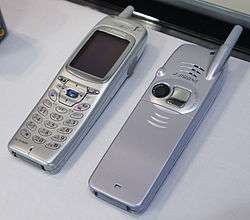J-SH04
The J-SH04 was a mobile phone made by Sharp Corporation and released by J-Phone (SoftBank Mobile). It was only available in Japan, and was released in November 2000. It was Japan's first phone with a built-in, back-facing camera. It has a 110,000 pixel CMOS image sensor and a 256 color display. The phone weights 74g, and its dimensions are 127 × 39 × 17 mm. It was succeeded by the J-SH05 flip phone, which was released just one month later.
 | |
| Manufacturer | Sharp |
|---|---|
| Availability by region | 1 November 2000 |
| Predecessor | J-SH03 |
| Successor | J-SH05 |
| Dimensions | 122 x 32 x 13 mm |
| Display | 256-color display |
| Rear camera | 110,000-pixels CMO Camera |
The J-SH04 has been asserted to be the world's first camera phone.[1] While the J-SH04 popularized the concept of a camera phone, it had a number of predecessors. In December 1997, Kyocera released the VP-110, which was a PCMCIA videophone adapter with a 80,000-pixel CCD camera that swiveled 210° and attached to the DataScope SD-110 and DS-320 mobile phones.[2] In addition, Kyocera released in September 1999 the Kyocera VP-210 Visual Phone which had a front-facing 110,000-pixel CMOS camera for video calling and selfie photos.[3] The VP-210 could send its still images as mail attachments or send video at 2 frames per second over a PHS network.[4] In contrast, the J-SH04's camera on the back of the phone was designed to take photos facing away from the user, which was a more popular way to use digital cameras at the time than video calling and selfie photos.
Samsung's SCH-V200 phone equipped with a VGA camera was released in South Korea several months before the J-SH04.[5] The Samsung SCH-V200's camera was inside the same case as the phone and used the same battery and memory, but it was not integrated with the phone function. It could not convey an image "at a distance," which some regard as part of the definition of a "camera phone."[6] Instead, photos taken by the SCH-V200 had to be transferred to a PC in order to be sent over a network.
help
References
- Debjit. "Sharp J-SH04: World's First Ever Phone With Integrated Camera". Digitizor Media & Web, Inc. Retrieved 26 August 2012.
- "京セラ、データスコープシリーズ新機種、専用テレビ電話アダプタも (1997-10-29)". PC Watch. Retrieved 16 February 2020.
- "First mobile videophone introduced (1999)". CNN. Retrieved 7 July 2014.
- "京セラ、TV電話つきPHS「VP-210」を7月末に販売 (1999-05-17)". Internet Watch. Retrieved 16 February 2020.
- "Samsung integrate digital camera and phone". Digital Photography Review. Retrieved 26 August 2012.
- "Sharp J-SH04 – first to discover the consumer love affair with the camera phone (2001)". Stephen Temple. Retrieved 6 April 2013.